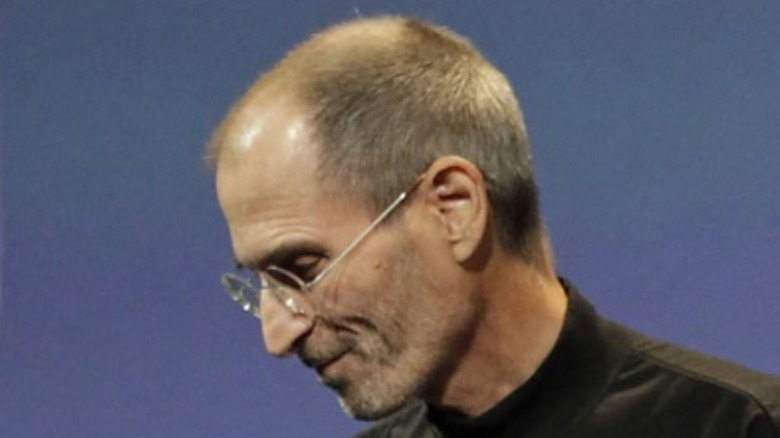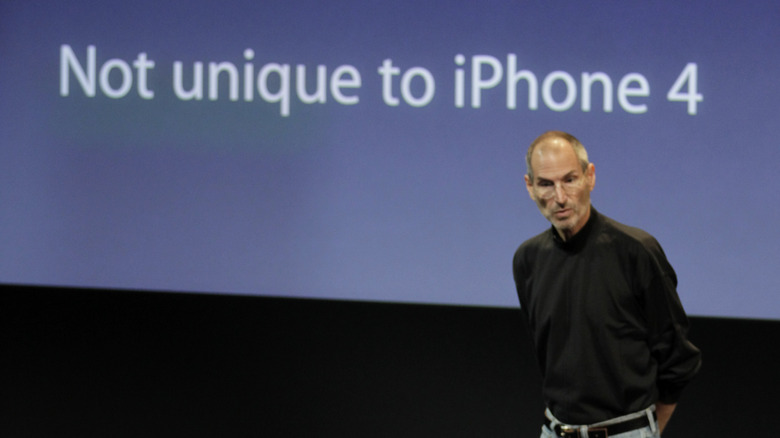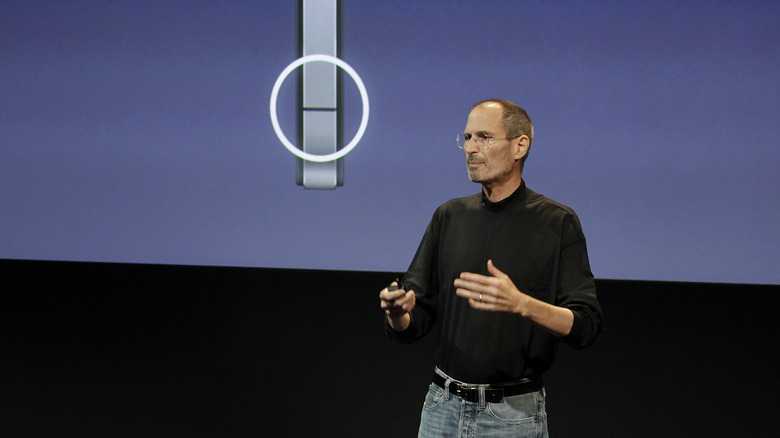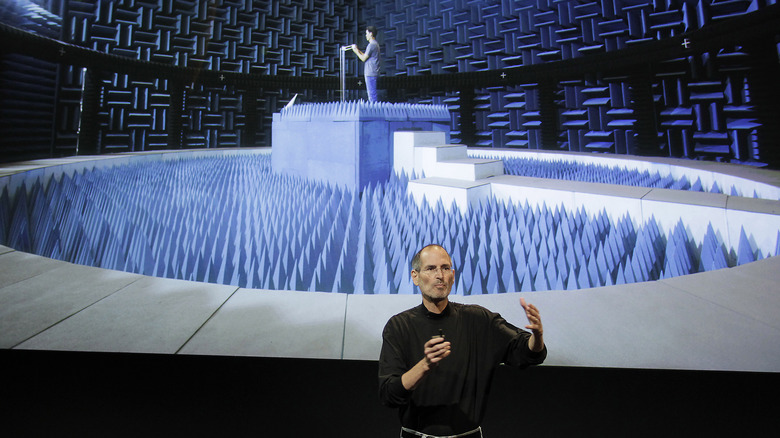Why Antennagate Was A Complete Disaster For Apple
Apple is one of the most celebrated companies of all time, and for good reason. It has been hugely influential for decades — even before it took as firm a leadership role as it has in the tech and gadget world today. Of course, that influence only grew on the back of massive hits like the iPod, the iPhone, and the Apple Watch. All of this success has led to Apple achieving a mind-boggling market cap that briefly reached $3 trillion in early January. However, for all its success, Apple has had some very public trip-ups — including most recently the lack of release for AirPower and the infamous butterfly keyboard fiasco.
One of Apple's biggest disasters, however, came with the launch of the iPhone 4. The late Steve Jobs triumphantly launched the iPhone 4 during the Apple Worldwide Developers Conference on June 7, 2010. The industrial design really stood out with its steel outer banding that also doubled as the device's antenna. Not long after its launch users started reporting issues with the cellular connectivity of the device. These customers noticed that when the iPhone 4 was held in a user's left hand that call connections became sketchy or dropped out altogether.
Apple plays the deflection game
The way that Apple handled the matter was also far from stellar and ultimately led to a class action settlement that saw the saga drag on for over two years, well after the launch of the iPhone 4 successor, the iPhone 4S. Initially, Apple tried to downplay the issue. In a letter to customers, it said a faulty software algorithm meant that iPhones didn't visually represent the cellular signal correctly. According to Apple, "Upon investigation, we were stunned to find that the formula we use to calculate how many bars of signal strength to display is totally wrong. ...We sometimes display 4 bars when we should be displaying as few as 2 bars." As true as this bit of information may have been, it wasn't the root cause of the issue.
An Apple spokesperson, Steve Dowling, compounded problems with Apple's response by trying to drag other phone makers into their mess. Speaking to The New York Times, Dowling said that "Gripping any phone will result in some attenuation of its antenna performance, depending on the placement of the antennas." Apple's letter, mentioned earlier, had specifically called out Droid, Nokia, and RIM phones as suffering from the same issues — needless to say, it was a claim that RIM, maker of the Blackberry, took offense to. Jobs even went on to infamously say "Just avoid holding it that way," which, in addition to being an inappropriate solution to a fundamental design flaw, also ended up launching a meme that still persists to this day.
The flaw with the iPhone 4 antenna
Prior to the iPhone 4, Apple's cellular antennae were located within the smartphone chassis, well away from the contact of a user's hands. This was changed radically with the launch of the iPhone 4 which had a metal band that wrapped around the outside of the frame that also functioned as the antenna. This meant that a user's hands could make direct contact with the antenna, affecting its signal. This effect was most prominently observed when the phone was held in a user's left hand. On the left side of the iPhone 4, there were two separate antenna parts that met at a junction point separated by a plastic spacer. When held in the left hand, this would create a bridge across the two antennas, changing their signal length and causing a cellular signal to become weakened or lost altogether (via Computerworld).
One of the big headlines at the time was a test of the iPhone 4's antenna by Consumer Reports. It confirmed the issues with the iPhone 4's antenna signal attenuation and announced that "Due to this problem, we can't recommend the iPhone 4." Consumer Reports offered users a couple of quick fixes which included using a piece of duct tape to cover the antenna gap while also stating that it was likely that using a protective case would also fix the issue. Although it still rated the iPhone 4 highly for all of its other merits, which included the first "Retina Display" on an iPhone, an excellent camera, and good software, the antenna issue lost the iPhone 4 its coveted "Recommended" badge. This was a major embarrassment for Apple, which has always touted the build quality and design of its products.
The fix was in
Rather than recalling the iPhone 4, as some people had been calling for at the time, Apple offered a couple of pathways for early adopters to assuage their concerns. At a special press event held on July 16, 2010, Steve Jobs delivered a keynote which he started by saying, "You know, we're not perfect. We know that. You know that. And phones aren't perfect either," which is as close as Jobs got to a mea culpa. Instead of acknowledging the iPhone 4 design fault directly, Jobs once again pointed to antenna attenuation that could be seen on competing phones — although it took rather exaggerated efforts on behalf of Apple's staff who held competing devices in a "death grip" to try to strangle out the signal.
Jobs acknowledged the Consumer Reports testing which referred to the use of a case to fix the problem. Jobs then announced that Apple would give all iPhone 4 owners and new customers over the coming three-month period a free iPhone 4 case from a selection that included Apple's own designs as well as those from third-party sources. Jobs also stated that Apple would offer a refund to customers who had already bought a case through the Apple Store for their iPhone 4. He also offered an extended 30-day return window for customers to return their iPhone 4 to Apple for a full refund. "We want to make everyone happy, and if we can't make you happy we'll give you a full refund," said Jobs.
Lingering questions
The sorry saga came to a conclusion nearly two years later when Apple settled a class-action lawsuit that delivered either a sum of $15 or a free case to all iPhone 4 buyers within a 120-day period. The debacle didn't, however, appear to impact iPhone 4 sales with millions of customers prepared to overlook the antenna flaw. It's highly likely that many of these customers either didn't know about the issue or assumed that their smartphone case — the case they would've purchased to protect the phone anyway — would nullify any antenna issue they might've otherwise had.
Questions, however, persisted about whether Apple knew about the potential problem before putting the device on sale. While Jobs denied Apple knew about any concerns with the iPhone 4 antenna, Bloomberg reported that Apple's senior antenna engineer knew about this issue and warned his superiors that the exterior antenna approach could cause signal issues. While we may never know the whole truth of the matter, there is no denying that Antennagate was a major hiccup in Apple's generally blemish-resistant history .



